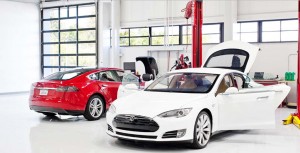It beat its own optimistic sales forecast, but battery-electric automaker Tesla Motors nonetheless dropped $50 million, or 40 cents per share, into the red for the first quarter of 2014.
But after excluding special one-time items, the Silicon Valley-based start-up managed to eke out a $17 million adjusted income, or 12 cents a share. That handily exceeded the consensus industry analyst forecast of 6 cents per share.
Tesla had a significant quarter, the maker coping with concerns about the safety of its battery packs – ultimately heading off a federal investigation by announcing plans to add a new, titanium safety cage underneath its Model S – while preparing for its much-anticipated product launch in the booming Chinese market.
While European sales failed to gain the momentum some optimistically anticipated, Tesla nonetheless exceeded its own first-quarter production forecast by about 2%, assembling 7,535 vehicles during the January through March period. The maker plans to continue ramping up production in the months ahead, with full-year output set to reach 35,000 battery cars.
(Click Here for a test drive of BMW’s new plug-in hybrid sports car.)
Adjusted revenue for the latest quarter came in at $713 million, up 27% from the $621 million generated during the first quarter of 2013.
Looking forward, Tesla has noted that it is finally selling cars in the world’s largest automotive market, CEO Elon Musk telling investors in a note announcing the earnings that, “We plan to expand in China as fast as possible because we believe the company could be one of our largest markets.”
The Chinese market could be particularly crucial for Tesla because it is not only world’s largest automotive markets but could soon become the biggest for alternative-powered vehicles, such as battery-cars, in a bid to reduce the endemic smog problem plaguing cities like Beijing and Shanghai.
(First drive: Mercedes-Benz B-Class Electric. Click Here for the review.)
China has some unique challenges for the battery-car industry, however, in that a large percentage of its population lives in major cities where it is difficult to set up a home recharging system. To get around that problem, Tesla plans to set up a national network of so-called Supercharger stations where Model S owners could go for a free 80% top-off of their batteries in less than an hour. The first Chinese station will soon debut in Shanghai.
Tesla is meanwhile moving ahead on the expansion of the U.S. Supercharger network.
(Click Here to learn about the strange warnings Tesla Model S owners have received in San Francisco.)
While the automaker appears to have dodged the bullet on the battery pack safety issue, it still does have its challenges. Those include the ongoing fight Tesla faces in New Jersey and a number of other states that do not intend to approve the automaker’s plans to set up factory-owned dealerships.
The maker has received support for that direct-to-buyer approach, most recently, it noted, from three directors of the Federal Trade Commission who “published a blog post that explained the many reasons why Tesla’s ability to sell directly is superior for consumers and why efforts to undercut that ability represent ‘bad policy,’” Tesla noted in its earnings release.
Growing production – and sales – will be one of the biggest hurdles in the coming months, but Tesla must also move forward on CEO Elon Musk’s latest pet project, a “Gigafactory” that would become the world’s largest supplier of lithium-ion battery technology when it goes into production around the end of the decade.

